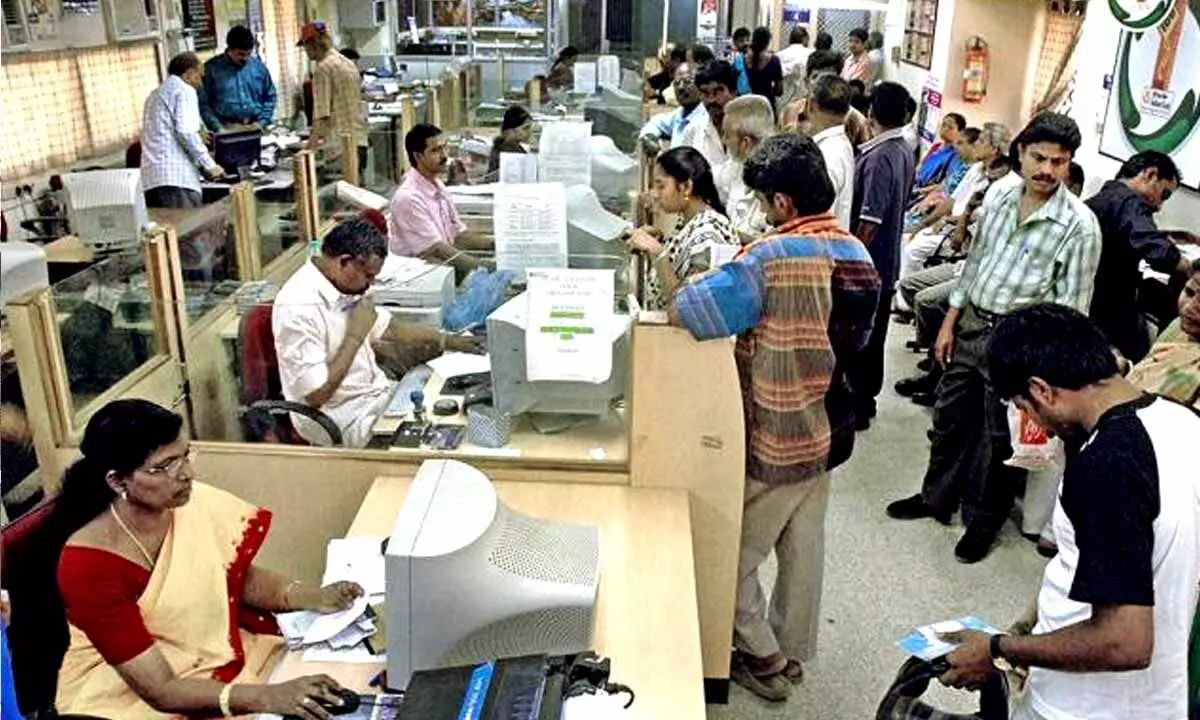From doom to boom: PSBs on journey towards Rs.1L cr profit
They have travelled a long distance since 2017 when they posted a net loss of Rs85,390 cr to a profit of Rs66,539 cr in FY22
image for illustrative purpose

How did PSBs become profitable?
• As part of the strategy, govt infused an unprecedented Rs3,10,997 cr to recapitalise PSBs during the last 5 fiscal years - from 2016-17 to 2020-21
• The recapitalisation programme provided much-needed support to the PSBs and prevented the possibility of any default on their part
• Also, the methodology of providing capital through the issuance of recapitalisation bonds is undertaken without impacting the fiscal deficit of the govt, except for the interest outgo
New Delhi: Public sector Banks have travelled a long distance since 2017 when they posted a net loss of Rs 85,390 crore to a profit of Rs 66,539 crore in FY22 and are estimated to touch a milestone of Rs 1 lakh crore by the end of the current fiscal. There was a time when 11 out of 21 PSBs were placed under the prompt corrective framework of the Reserve Bank due to deteriorating financial health on account of mounting bad loans to alarming levels of 14.58 per cent of the total credit. PSBs suffered from a host of problems, including a dismally low capital base, unprofessional management, demoralised staff and huge inefficiencies.
Many of them were on the brink of default posing a threat to the financial security of the country. Their share prices were hitting a rock bottom. PSBs booked collective losses to the tune of Rs 2,07,329 crore for five straight years - from 2015-16 to 2019-20. The highest amount of net loss was registered in 2017-18 at Rs 85,370 crore, followed by Rs 66,636 crore in 2018-19; Rs 25,941 crore in 2019-20; Rs 17,993 crore in 2015-16 and Rs 11,389 crore in 2016-17. The doom-to-bloom story of the public sector banking industry can be attributed to the initiatives and spate of reforms undertaken by the government led by Prime Minister Narendra Modi, along with the then Finance Minister Arun Jaitley and Financial Services Secretary Rajiv Kumar.
As part of the strategy, the government infused an unprecedented Rs 3,10,997 crore to recapitalise PSBs during the last five financial years - from 2016-17 to 2020-21. The recapitalisation programme provided much-needed support to the PSBs and prevented the possibility of any default on their part. Also, the methodology of providing capital through the issuance of recapitalisation bonds is undertaken without impacting the fiscal deficit of the government, except for the interest outgo. While announcing the recapitalisation programme in October 2017, Kumar had termed PSBs as 'Article of Faith' and the very faith is being validated by the financial sector experts and markets.
Simultaneously, efforts were made to curb the circulation of black money in a layered fashion. Days after joining the Department of Financial Services, Kumar froze bank accounts of about 3.38 lakh shell companies that were being used for creating fictitious equity. Due to record recovery in FY19, PSBs' Credit Risk-weighted Assets (RWAs) to Gross Advances ratio decreased from 80.3 per cent in September 2017 to 63.9 per cent in December 2019. As part of the reform agenda, the politically sensitive decision of privatising a PSB was taken to give a signal that the government is really committed to reforms and can bite the bullet.
After hectic parlays, the majority 51 per cent stake of IDBI Bank was sold to LIC in January 2019, making it a private sector bank. Aided by the capital infusion and nudge from the Department of Financial Services compelled PSBs to step up action on defaulters who committed fraud. Action against big defaulters like Bhushan Steel, Jet Airways, Essar Steel, Nirav Modi and Rotomac along with bankers like Yes Bank, DHFL, IL&FS, etc. fundamentally corrected the imbalance in the creditor-debtor relationship.
As a result, the PSBs, which reeled under the stressed assets, bounced back with a vengeance and have started giving a tough fight to private sector peers on all counts. They turned the corner during 2020-21 with a combined net profit of Rs 31,820 crore, supported by impressive loan recovery, reduction in NPAs and windfall gains on their bond portfolio.

